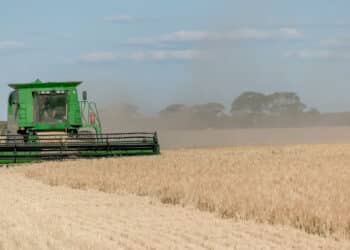Labor challenges weigh on equipment industries
92% of construction firms struggling to find workers
Solving labor issues is at the forefront of OEM strategies, but some innovations create both challenges and opportunities for equipment lenders.
Going into 2025, the construction industry needed about 439,000 more workers to meet demand driven by large infrastructure projects, data centers and other commercial developments, according to Associated Builders and Contractors. Ninety-two percent of construction firms are struggling to find workers, according to an Aug. 28 report by the Associated General Contractors of America, noting that labor shortages are the leading cause of project delays.
Essentially all heavy-equipment industries have the same problem. Fifty-six percent of farmers reported labor shortages in 2024, according to advisory firm FTI Consulting, and the American Trucking Associations estimates a shortage of roughly 60,000 drivers.
Inadequate labor can especially weigh on small businesses as it hinders cash flow and “their ability to be creditworthy, to get financing,” David Johnson, president of Charlotte, N.C.-based outdoor power OEM Positec Americas, told Equipment Finance News.
And while some equipment innovations are easing labor challenges, they typically require significant upfront costs. An autonomous forklift, for example, may cost between $100,000 and $120,000, compared with about $25,000 for a conventional model, according to autonomous technology provider BlueBotics.
Limited performance data and residual value uncertainty for tech-driven machines also are challenges for lenders, Crest Capital President Mark French previously told EFN.
At the same time, higher equipment prices make financing more of a necessity and priority for OEMs, Positec’s Johnson said. In fact, the company is encouraging customers to finance the new Kress Voyager mower, which costs $60,000, over five years, he said.
Innovation with purpose
OEMs recognize that the dearth of skilled, reliable labor is “the biggest pain point” facing customers, Kevin Scotese, global director of digital innovation strategy and product portfolio at CNH Industrial, told EFN.
“They don’t know if that guy that ran the dozer yesterday might not show up tomorrow,” he said.
Similarly, for outdoor power equipment manufacturer The Toro Co., “the No. 1 challenge that we hear from our contractors is labor availability,” Director of Marketing Nolan Bangert said at Equip Expo in Louisville, Ky., last month.
Although it’s a challenge, the labor shortage is also an opportunity for OEMs to introduce new equipment types and technologies that boost efficiency and usability, Justin Noland, a senior product operations manager at Kubota Tractor, told EFN.
“With labor shortages facing the landscaping industry, doing more with less is basically across the board,” he said. “What products do we have to support their needs when we come out with new technologies? How can these landscapers implement those new technologies to become more efficient, more profitable?”
Kubota is offering 1.99% financing over 48 months for new turf equipment featuring improved ergonomics, shifting performance and maintenance readings, Noland said.
At Equip Expo, CNH Industrial showcased new machine control technology to simplify and streamline the excavation process, Scotese said.
The machine control comprises a traditional 2D system that projects a 360-degree light beam to establish a precise elevation reference point, with sensors for the chassis, boom, bucket, stick and tilt. These features enable consistent accuracy, enhanced customization and higher productivity, according to the company.
Beginning later in 2026, CNH customers can upgrade to a 3D system, providing full positional awareness and adjusting guidance in real-time as the machine moves. This option to upgrade is especially conducive to addressing labor challenges, Scotese said.
“Having a 2D system that’s easy, intuitive for the operator to learn, it can make it where one operator can do much more work in a shorter amount of time,” he said. “We’re helping the customers’ pain point in a slow, easy, understandable way. And once you get familiar with that, you can upgrade to 3D, which will improve his productivity even more.”
The system is powered by wholly owned CNH subsidiary Hemisphere GNSS, a machine technology provider. Having full ownership of Hemisphere streamlines financing because the technology and equipment can be financed through CNH Industrial Capital in one transaction, Scotese said.
Autonomous equipment
Autonomous machines are becoming increasingly capable of carrying out tasks with no human oversight. For instance, autonomous trucking company Bot Auto recently completed its first driverless hub-to-hub validation run in Houston, operating without a person in the cab or remote assistance.
Moreover, Positec Americas subsidiary Kress and Toro recently unveiled autonomous mowers, designed to operate with minimal to no human oversight. Toro’s new proline AMI autonomous mower is “helping to solve that labor challenge,” Bangert said.
Despite residual value challenges, lenders are beginning to explore asset-backed loans, usage-based financing and full-service leasing structures to support autonomous equipment, Bot Auto Vice President of Business Development Robert Brown previously told EFN.
Check out our exclusive industry data here.








